RetroLisa
---------- |
1910s In The News | |
|
___________________________________________________________________________________________________________
|
|
|
RetroLisa
| ________________________________________________ | ___ | ______________________________________________ | ________ | Dark Days

the influenza pandemic
Few things were as horrible as the influenza outbreak of 1918.
origins
The disease was caused by a bird virus, which became deadly after being passed from pigs to humans. Early cases were reported in Europe and Asia as far back as 1916. The epidemic began in March 1918 when the virus began to infect hundreds of soldiers stationed in American military camps.
transmission
By April 1918, the virus had spread to American troop ships. Carried by the soldiers, the disease quickly spread to Europe, Japan, Africa, and South America. Civilians transmitted the disease when they attended Liberty Bond rallies and gathered in crowded buildings to register for the draft. World War I had taken a series of local outbreaks and transformed them into a global epidemic.
Many people blamed the war itself for the outbreak. Chemical warfare was a new concept, and mustard gas was quickly added to the list of possible influenza causes. Other people believed the virus was a German biological weapon.
virus behavior
The virus acted with alarming swiftness. At Camp Funston in Kansas, the number of cases grew from one to over 500 in less than a week. Symptoms appeared very quickly, and in the most severe cases the victims were dead within 24 hours. The disease also acted very strangely. It hit a city for two to three weeks, and then left as quickly as it came. Unlike most influenza strains, the majority of its victims were adults between the ages of 20 and 40, people in the prime of their lives.
illness & death
The influenza virus destroyed lung tissue and caused the lungs to fill with fluid. Patients developed a distinctive blue tinge to their faces when skin cells were depleted of oxygen. Death was caused by severe pneumonia. Family members who watched their loved ones die in this way were affected by the tragedy for the rest of their lives.
The Influenza Pandemic Of 1918
Influenza 1918
The Great Pandemic
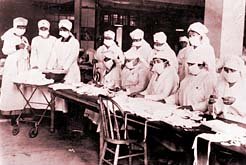
| |
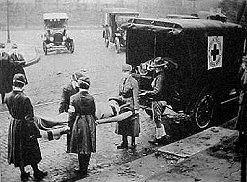
treatment & prevention
Although modern medicine was making great strides in the 1910s, doctors were powerless to stop the disease. There were no antibiotics, no effective influenza vaccines, and no way to study or identify the virus. The situation was complicated by the fact that many doctors and nurses were serving at the front, leaving medical students to deal with the epidemic here at home.
Prevention measures also proved futile. People were ordered to wear masks in public, and travelers in some areas were required to carry signed health certificates. Sick people were quarantined and public areas were regularly sprayed with disinfectant. Healthy citizens were urged to take daily treatments of nose and throat sprays. People kept their windows open all winter long in the hopes that proper ventilation would help prevent infection.
When these measures failed, officials began to ban public gatherings. Theaters, restaurants, and taverns were closed. Nonessential social functions were prohibited. In many areas, church services and funerals were limited to 15 minutes. Many schools also closed.
outcome
The results of the epidemic were staggering. 60 percent of the Eskimo population of Nome died. Ocean liners arrived from Europe with 7 percent fewer passengers than they embarked with. Homes and barracks became temporary hospitals, and morticians couldn't keep up with the demand for their services. Many businesses and farms halted their operations because there weren't enough healthy workers to keep things going. People isolated themselves from society and treated their neighbors as enemies. The number of deaths was so great that it reduced the average American lifespan by ten years.
The virus swept the globe in three waves. The second wave was the most severe, and October 1918 was the deadliest month. Overall, 850,000 people died in the United States and approximately 30 million people died worldwide.
A pandemic is an epidemic that spreads throughout the world. This pandemic lasted for 18 months. In September 1919, the virus vanished as quickly and mysteriously as it had come.
|

RMS Titanic
The Titanic and her sister ship, the Olympic, were owned by the White Star Line. The Titanic was completed in 1912. On April 10th of that year, she set sail from Southampton, England on her maiden voyage.
The Titanic was following all of the safety rules in place at the time. Unfortunately, most of these rules were horribly outdated. The ship was regarded as unsinkable, which made the possibility of a deadly maritime disaster virtually inconceivable. As a result, there were not enough lifeboats on board for everyone. There were no laws preventing flare guns from being used for non-distress purposes. In the Marconi wireless room, personal messages from passengers took priority over safety bulletins, and the console was often unmanned for long periods of time.
iceberg
On April 14th, ice warnings were received throughout the day from other ships in the northern Atlantic, but they were basically ignored.
The weather that night was clear and cold. The lookout in the crow's nest saw the iceberg and called out a warning, but it was too late. The ship struck the iceberg, and the resulting 300-foot gash buckled the steel hull and popped the rivets. The watertight compartments began to fill with water. It was 11:40 p.m.
Titanic-Titanic
Encyclopedia Titanica
CQD & SOS Distress Calls
The Titanic Radio Page
| |
As the ship began to list, flares were shot into the night sky and distress calls were sent from the Marconi room. Both the traditional CQD and new SOS distress calls were used. Ten miles away, the Californian disregarded the flares and failed to respond to the SOS, having turned off their wireless equipment for the night. The Carpathia was 58 miles away; she picked up the wireless calls and headed to the rescue.
Meanwhile, the lifeboats were being loaded with upper class women and children. Steerage passengers found it very difficult to get to the main deck. Many lower class passengers were turned away by class-conscious crew members who felt that their duty was to attend to the upper classes first.
It took approximately three hours for the ship to break into two pieces and sink to the ocean floor. Out of 2,227 crew and passengers, only 705 survived. The Carpathia arrived at 4:00 a.m., and within four hours all of the survivors had been picked up.
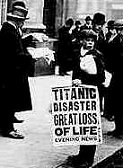
As the rescue efforts progressed, reports were transmitted to the Marconi shore station at Cape Race, Newfoundland. They were picked up by many other stations and wireless buffs, including David Sarnoff at Wanamaker's Department Store in New York City. All of this confusion resulted in some horribly innacurate early reports.
|
__________________________________________
|
|
|
RetroLisa
| ________________________________________________ | ___ | ______________________________________________ | ________ | Law & Order
wet vs. dry
the temperance movement
Throughout the 1800s, many people considered the consumption of alcoholic beverages to be America's biggest problem. Refraining from alcohol was known as temperance.
After the Civil War, women took up the cause with a vengeance. This resulted in the formation of the National Prohibition Party in 1869, the Women's Christian Temperance Union in 1874, and the Anti-Saloon League in 1895. During the 1890s and 1900s, Carry Nation lectured against alcohol and smashed saloons with her cane and hatchet.
taking the pledge
Many temperance organizations were formed during the 1800s. Members attended meetings, listened to temperance orators, wore special badges, and took a pledge to refrain from alcohol. Many of the groups contained both men and women, and some even included children.
voting to go dry
A town was dry if it banned the sale and consumption of alcohol within its borders. This policy was known as prohibition and was enforced by dry laws. The first statewide dry laws were passed in the 1850s, but they proved highly unpopular and were soon repealed.
Between the 1880s and the 1910s, prohibition became fashionable again. Gradually, the number of dry towns and counties began to increase. My town voted to remain wet in 1910, but voted to go dry in 1914. Statewide prohibition also returned during this time. There were eight dry states in 1909, 14 dry states in 1914, and 26 dry states in 1917.
suffrage and prohibition
During this time, women were campaigning for the right to vote. Many men, especially those in the liquor industry, were reluctant to grant votes for women. They were afraid that if they did, women would legalize temperance. For the most part, they were right. In towns where women were allowed to vote on local issues, their votes often resulted in dry victories.
| |
liquor industry complacent
The noisy, rowdy saloon atmosphere was also a target of the temperance movement. Because brewers, distillers and saloon owners didn't believe prohibition could ever succeed, they made no attempt to change their business practices or improve the saloon atmosphere. Even after national prohibition was proposed, they didn't fight back. They assumed that this whole prohibition thing would just "go away."
national prohibition proposed
In 1913, the Anti-Saloon League began to push for national prohibition. This would make alcoholic beverages illegal everywhere in the United States. At the time, the idea was appealing for several reasons that had nothing to do with drinking. Established citizens were becoming increasingly paranoid, and they were convinced that recent immigrants were planning anarchist revolutions in taverns. If nothing else, prohibition would remove these immigrant hotbeds of rebellion.

For prohibition advocates, World War I came along just in time. Thanks to wartime propaganda and anti-German sentiment, boycotting German brewers became the patriotic thing to do. It was also pointed out that with prohibition, grain that was previously used to make alcohol would provide millions of loaves of bread for America and her allies.
national prohibition becomes law
Congress introduced a national prohibition bill in 1917. It passed both houses and was sent to the states for ratification. The bill was ratified in 1919 and became the 18th Amendment to the Constitution. National prohibition went into effect in 1920.
After the bill was introduced in Congress, many remaining wet states chose not to wait for ratification. Between 1917 and 1919, an additional seven states voted to go dry. When the amendment was ratified, there were already 33 dry states.
|
__________________________________________
|
|
|
RetroLisa
| ________________________________________________ | ___ | ______________________________________________ | ________ | The Lighter Side
the Cottingley fairies
In 1917, two English cousins, Elsie Wright and Frances Griffiths, announced to family and friends that they had seen and photographed fairies in their Cottingley garden. Two blurry photos showing the girls posing with tiny winged creatures were circulated in the town, where they caused a minor sensation.
In 1919, Elsie's mother shared the story at a lecture on paranormal phenomena. Copies of the photos were sharpened and analyzed, but all they revealed was that the film itself had not been tampered with.
During the summer of 1920, researchers asked the girls to photograph more fairies. Elsie and Frances produced three more photos, which also showed no evidence of film tampering.
The Cottingley Fairies
| |
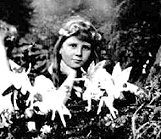
Later in 1920, the original photos came to the attention of Sir Arthur Conan Doyle, the author of the "Sherlock Holmes" stories. He was so enchanted by the story that he wrote about it in the Christmas 1920 issue of "The Strand" magazine. A minor local event from three years earlier became a national sensation. The second set of photos were featured in a "Strand" article in 1921.
The origin of the photos would remain a mystery for 60 years (the figures were paper cutouts attached to hat pins). During this time, no one bothered to inquire as to why the fairies had such stylish clothing and hairstyles, or why no one accompanied the girls when they made their second set of photos!
|
__________________________________________
|
|
|
RetroLisa
| ________________________________________________ | ___ | ______________________________________________ | ________ | World Stage
Russian Empire in turmoil
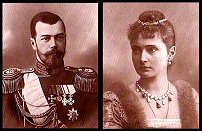
before the 1910s
The Russian Empire was ruled by Czars for 300 years. The last Czar, Nicholas II, was coronated in 1896. Although he basically had good intentions, he was a weak man who made poor decisions. Throughout the 1900s, the country was besieged by violent labor strikes, small revolts, extreme poverty, and a disastrous war with Japan. The Czar's inability to effectively deal with these issues made him an increasingly unpopular ruler.
Alexandra & Rasputin
Czarina Alexandra Feodorovna was the wife of Czar Nicholas. She was German by birth, which made her very unpopular with the Russian people. Grigori Rasputin was a self-proclaimed Holy Man who became the royal family's spiritual advisor in 1905. Nicholas deferred to Rasputin when making many important decisions, and both his marriage to Alexandra and his reliance on Rasputin did nothing to help his popularity.
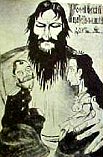
Cartoon depicting the Czar and
Czarina as Rasputin's puppets
new ideologies
During the late 1900s and early 1910s, Czar Nicholas made some positive changes, but they were not enough. Many revolutionary groups began to emerge. Most of these groups favored socialism, in which society and all means of production are controlled by the working class. Russian socialist groups included the Bolsheviks, the Mensheviks, and the Party of Social Revolutionaries. Throughout the country, soviets (socialist councils) were formed. In addition to this, the creation of the Constitutional Democratic Party proved that socialism was not the only idea being tossed around.
World War I intervenes
The Great War began in 1914 when Austria-Hungary declared war on Serbia. Russia was drawn into the conflict due to an alliance with Serbia. Another alliance brought Germany into the war against Russia. This created a wave of anti-German sentiment, which was very unfortunate for Czarina Alexandra.
The war went very badly for Russia. The army was rushed into combat without adequate supplies, modern weapons, or proper training. By 1915, Russia had lost Poland, Lithuania, and the Ukraine. When Nicholas assumed supreme command of the army in 1916, his inexperience and lack of leadership skills created a catastrophe.
| |
Russia in revolt
bread! peace! freedom!
In 1916, while Nicholas was commanding the troops, control of the country was left to Alexandra and Rasputin. People were starving, the protests increased, and soldiers were dying or deserting by the thousands. The public accused Alexandra of being both Rasputin's lover and a German spy. When Nicholas failed to take positive action, family members and associates took matters into their own hands and murdered Rasputin.
When bread was rationed in March 1917, it was more than the people could take. The protests turned to riots and looting. Their rallying cry was "Bread! Peace! Freedom!"
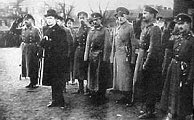
abdication & a new government
Czar Nicholas II was forced to give up the throne in March 1917. He and his family were placed under arrest and a provisional (interim) government was established. The first leader was Alexander Kerensky of the Party of Social Revolutionaries.
The leaders of the various socialist groups saw their chance to campaign for support and help form the new government. One of these leaders was Vladimir Lenin, the exiled leader of the Bolshevik party. In April 1917, he returned to Russia on a special sealed train with hopes of overthrowing the provisional government and establishing socialism.
ten days that shook the world
In October 1917, the Bolshevik party began their revolution in Petrograd. They seized power from the provisional Kerensky government, took over the Winter Palace, and seized the estates of many Russian noblemen and merchants. Throughout the country, new soviet councils were formed.
red army, white army
The Bolsheviks became known as the Red Army. The monarchists who wished to see a return of the old royal system became known as the White Russians, or White Army. During 1918 and 1919, control of individual towns and regions alternated between the two sides.
Bolsheviks & socialism triumphant
In 1920, the Bolshevik party finally gained complete power. Lenin, the leader of the Bolshevik party, became the leader of the new Soviet Russia.
|
the royal family
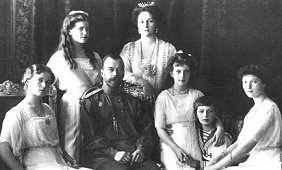
The imperial Romanov family
public knowledge
family imprisoned
Following the abdication of Czar Nicholas II in March 1917, he and his family were placed under arrest. Between March 1917 and April 1918, they were held in the Alexander Palace near Petrograd, and then in the Siberian city of Tobolsk.
In April 1918, they were taken to the Ural Mountain town of Ekaterinburg. Here, they were imprisoned at the Ipatiev House for 78 days. Accompanying them were the family physician and three servants.
mysterious disappearance
After July 1918, the royal family was never seen again. The Russian newspapers declared that the Czar had been executed. As for the Czarina and her children, there were many rumors, reported sightings, and escape theories. In the autumn of 1918, both the German and British authorities began to fear that the entire family had been killed, although Russian officials continued to claim that they were safe.
| |
what really happened
uncertain fate
In 1918, the Bolsheviks were undecided about what to do with the royal family. The local Ural Soviet wanted to execute them. Lenin's aide, Leon Trotsky, wanted to put Nicholas on trial. Lenin wanted to use them as bargaining chips in the war with Germany, since Alexandra was a German princess and first cousin to Kaiser Wilhelm.
In July 1918, the White Army was advancing very quickly towards Ekaterinburg. The Bolsheviks began to panic, and the fate of the royal family was left to the local Ural Soviet, who decided to execute them.
July 16-17, 1918
In the middle of the night, the royal family and their four servants were awakened and told to dress quickly. They were taken to the cellar, lined up against the wall, and shot. Three daughters did not die right away, and their executioners were forced to beat them to death with their weapons. Later it was discovered that the bullets had been deflected by 18 pounds of diamonds sewed into their corsets. Alexandra had several pearl necklaces sewed into her belt.
burial
The bodies of the royal family and servants were taken to the woods and dumped down a mine shaft. Shortly afterwards, they were moved to another spot in the woods. Their executioners attempted to burn two of the bodies, but this proved unsatisfactory. The remains of the two bodies were buried at the burn site and the rest were buried in a shallow grave a short distance away.
the white army enters
The White Army entered Ekaterinburg eight days after the execution. At the Ipatiev House, they found personal effects of the royal family and evidence of the horrible slaughter in the cellar. In 1919, acting on a hunch, Nicholas Sokolov examined the abandoned mine shafts in the woods. At the bottom of one of the shafts he found more personal effects and a few charred bones, but no bodies. He took these items with him.
red army returns
Later in 1919, the Red Army regained control of the Ekaterinburg area. All investigations into the whereabouts of the royal family were halted.
|
__________________________________________
|
|
|
